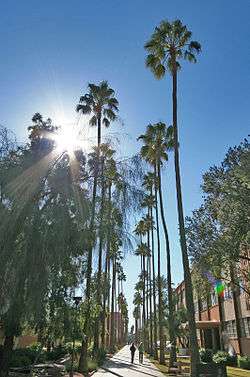Washingtonia robusta
| Washingtonia robusta | |
|---|---|
 | |
| Mexican Washingtonias planted in Los Angeles County Arboretum and Botanic Garden | |
| Scientific classification | |
| Kingdom: | Plantae |
| (unranked): | Angiosperms |
| (unranked): | Monocots |
| (unranked): | Commelinids |
| Order: | Arecales |
| Family: | Arecaceae |
| Genus: | Washingtonia |
| Species: | W. robusta |
| Binomial name | |
| Washingtonia robusta | |
| Synonyms[2] | |
|
Synonymy
| |
Washingtonia robusta (Mexican fan palm or Mexican washingtonia) is a palm tree native to western Sonora, and Baja California Sur in northwestern Mexico. It is reportedly naturalized in Florida, California, Hawaii, Texas, parts of the Canary Islands, Italy, Spain, and Réunion,[3][4]
Description
Washingtonia robusta grows to 25 m (82 ft) tall, rarely up to 30 m (98 ft). The leaves have a petiole up to 1 m (3.3 ft) long, and a palmate fan of leaflets up to 1 m long. The inflorescence is up to 3 m (9.8 ft) long, with numerous small pale orange-pink flowers. The fruit is a spherical, blue-black drupe, 6–8 mm (0.24–0.31 in) diameter; it is edible, though thin-fleshed.[5]
Cultivation and uses

Like the closely related Washingtonia filifera (California Fan Palm), it is grown as an ornamental tree. Although very similar, the Mexican Washingtonia has a narrower trunk (which is typically somewhat wider at the base), and grows slightly faster and taller; it is also somewhat less cold hardy than the California Washingtonia, hardy to about −8 °C (18 °F).
Field research conducted on Washingtonia robusta in its native habitat on the Baja California peninsula concluded that its potential longevity may exceed 500 years.[6]
Supporting research by Barry Tomlinson and Brett Huggett states that there is "evidence for extreme longevity of metabolically functioning cells of considerable diversity in palm stems."[7] Many of the iconic "sky dusters" of Los Angeles that have survived the chainsaws of progress are documented in photography from the 19th century.
Unlike Washingtonia filifera, which has been cultivated as far north as Utah, the Mexican fan palm is normally grown in the desert southwestern United States, in areas such as California, Arizona, Southern Nevada, New Mexico and Texas. It also cultivated in the coastal areas of south Atlantic states and Gulf Coast, including extreme southern North Carolina, coastal South Carolina, southern Georgia, and Florida. Along the Gulf Coast, Mexican fan palm can be found growing along the Florida west coast westward to southern Texas.
Washingtonia × filibusta is a hybrid of W. robusta and W. filifera and has intermediate characteristics of the two parents, especially greater tolerance of wet cold.[8]
Gallery
 Flowering palm in Chandler, Arizona
Flowering palm in Chandler, Arizona- Infructescence
- Inflorescence
 Arizona State University's Palm Walk
Arizona State University's Palm Walk- Species in Venice Beach, California
 Washingtonia robusta and Canary Island Date Palms are commonly seen lining many streets throughout San Jose, California
Washingtonia robusta and Canary Island Date Palms are commonly seen lining many streets throughout San Jose, California
 Species line Santa Clara Street in San Jose, California
Species line Santa Clara Street in San Jose, California Oldest palms in Los Angeles, planted circa 1875.
Oldest palms in Los Angeles, planted circa 1875. A Mexican Fan Palm tree in Enterprise, Alabama
A Mexican Fan Palm tree in Enterprise, Alabama
References
| Wikimedia Commons has media related to Washingtonia robusta. |
| Wikispecies has information related to Washingtonia robusta |
- ↑ "Washingtonia robusta". Germplasm Resources Information Network (GRIN). Agricultural Research Service (ARS), United States Department of Agriculture (USDA). Retrieved 2010-07-17.
- ↑ The Plant List
- ↑ Kew World Checklist of Selected Plant Families,Washingtonia robusta
- ↑ Biota of North America Program 2014 county distribution map
- ↑ Flora of North America Vol. 22 Page 106 Mexican fan palm, palmier évantail du Mexique Washingtonia robusta H. Wendland, Garten-Zeitum (Berlin). 2: 198. 1883.
- ↑ Bullock, S.H.; Heath, D. "Growth rates and age of native palms in the Baja California desert". Journal of Arid Environments. 67 (3): 391–402. doi:10.1016/j.jaridenv.2006.03.002.
- ↑ Tomlinson, P. Barry; Huggett, Brett A. (2012-12-01). "Cell longevity and sustained primary growth in palm stems". American Journal of Botany. 99 (12): 1891–1902. doi:10.3732/ajb.1200089. ISSN 0002-9122. PMID 23221497.
- ↑ Riffle, Robert Lee (2008). Timber Press Pocket Guide to Palms. Timber Press Pocket Guides. Portland, Oregon: Timber Press. p. 224. ISBN 978-0-88192-776-4.